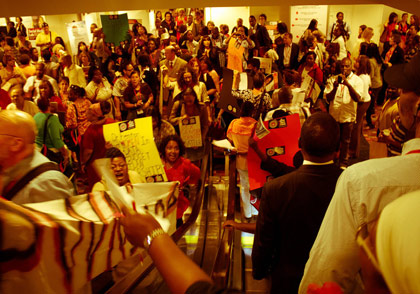Sponsored by the U.S. Centers for Disease Control and Prevention (CDC) and 40 other public and private agencies, the 2011 National HIV Prevention Conference was held August 14 to 17 in Atlanta. More than 3,000 public health workers and community leaders attended.
Among the topics discussed were treatment as prevention for both HIV-negative people and those living with the virus, as well as the recent CDC data showing a continuous rise of HIV cases among gay and bisexual men, especially young African-American men.
Also discussed was high-impact prevention. This new approach to HIV prevention by the CDC focuses on programs that have demonstrated the greatest potential in high-risk groups and implements them on a scale large enough to yield the greatest possible impact. 
Along with high-impact prevention is the reallocation of federal funding to geographic areas that are currently, rather than historically, most impacted by HIV.
Advocates focused on HIV among women were angered by the invisibility of their issues in both the conference and the National HIV/AIDS Strategy (NHAS).
“Women are not on the priority list—that’s crystal clear,” said Naina Khanna, director of policy and community organizing for Women Organized to Respond to Life-threatening Disease (WORLD) and coordinator of the U.S. Positive Women’s Network (PWN).
“They keep telling us that we are, that where it says African Americans, Latinos, etc., that includes women. But until there are specific targets in the NHAS on reducing HIV incidence among women and getting us into care, we are not really in the plan,” said Khanna. “If no specific goals are articulated, then there is no accountability for accomplishing those goals. They keep describing the NHAS as a living document. If that’s the case, we want to know what the process is for bringing about changes in it.”
These frustrations were expressed in two demonstrations during the conference.
“CDC, hear us shout / Make us a priority / Women count” was chanted by about 20 women and male allies at the end of a plenary session on August 16. Hundreds of conference attendees found themselves temporarily stalled as two of the escalators running between the main conference floors were blocked by the high-energy action.
The protesters formed a continuous loop, riding over and over up one escalator and then down the adjacent one. Their signs and loud chanting met with surprise and support from many inconvenienced conference attendees, especially by women who cheered and chanted from the sidelines. The loop of bodies more than doubled in size as women spontaneously joined the action. “Make women count in data, budgets, planning and leadership” was written on brightly colored signs.
At the close of the action, Khanna noted that the message on those signs was directed at Kevin Fenton, director of the National Center for HIV/AIDS, Viral Hepatitis, STD and TB Prevention at the CDC. because the CDC needed to count all women accurately. “Transwomen are not men who have sex with men, and ‘non-identified risk’ is not a risk category,” said Khanna.
The primary demand of the protesters was that at least 30 percent of HIV funding and resources in the United States and its territories be devoted explicitly to addressing issues that are of high priority to women. This demand comes from 30 for 30, a coalition of national and some regional women-focused organizations that formed in May 2011 after the release of the NHAS.
C. Virginia Fields, president and CEO of the National Black Leadership Commission on AIDS, is a co-founder of 30 for 30. She describes it as a “campaign focused on assuring that women don’t continue to be left behind as new funding is allocated and new directions set for the [CDC] 12 cities project and the [NHAS].”
The coalition has had meetings with White House staff, the Health Resources Services Administration, which administrates the Ryan White CARE Act, and Fenton at the CDC.
“Women continue to represent almost 30 percent of the epidemic in the United States. In Puerto Rico and the U.S. Virgin Islands, it is higher than 30 percent,” said Fields. “We want to assure that women aren’t short-changed in funding, planning and outcomes.”
The other action occurred during a plenary session on August 17. Conference attendees found bright pink “Count Me In!” flyers on their chairs when they arrived at the session. Michelle Lopez, chair of the National Association of People With AIDS (NAPWA) and the first speaker at the session, interrupted her prepared remarks to call on the audience to stand and hold up a flyer if they supported the demand for proportionate funding and attention to the needs of women.
Activists then lined up in front of the stage chanting “Stand up!” as Lopez asked over and over, “Can women count on you?” More than half of the audience stood up to show solidarity. “This is really exciting. I feel like I have been waiting a long time to see something like this,” said one audience member afterward. “Now I can tell the women we serve and other women in my agency that someone is paying attention to us.”






2 Comments
2 Comments